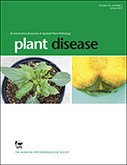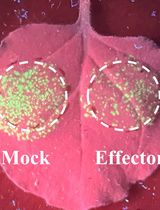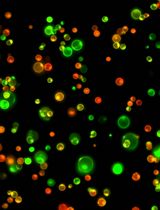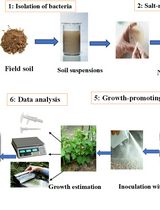- EN - English
- CN - 中文
An Efficient Inoculation Technique to Assess the Pathogenicity of Pantoea Species Associated to Bacterial Blight of Rice
一种用于评估水稻白叶枯病泛菌致病性的高效接种技术
发布: 2020年09月05日第10卷第17期 DOI: 10.21769/BioProtoc.3740 浏览次数: 5309
评审: Mohammad Malek Faizal AziziAnonymous reviewer(s)
Abstract
Bacteria blight diseases of rice due to several genera of pathogenic bacteria are one of the major constraints worldwide for rice production. The disease can be best managed through host plant resistance sources. For most of these bacteria such as Xanthomonas oryzae pv. oryzae, X. oryzae pv. oryzicola, Pseudomonas fuscovaginae, Burkholderia glumae, Burkholderia gladioli and Acidovorax avenae subsp. avenae, specific diagnostic techniques that include molecular and pathogenicity tests have been developed.
However, for Pantoea spp., information on pathogenicity assay is very limited and protocols used are not uniform. Most authors use the leaf clipping method. In this paper, we describe the protocol for mechanical inoculation of rice seedlings aged 35 days. The method consists of infiltrating bacterial suspensions at concentrations of 108 CFU/ml, with a needleless syringe into the intercellular and interveinal spaces of rice leaves underside at about 4-5 cm below the leaf tip.
This method can be used for a standardized pathogenicity assessment, germplasm resistance evaluation for identifying and characterizing resistance sources.
Background
The rice species Oryza sativa is the most widely consumed staple food for a large part of the world's human population, especially in Asia and Africa (Nwanze et al., 2006; Somado et al., 2008; Gnanamanickam, 2009). Its production contributes to fight against food insecurity and reduce poverty. In Africa, rice self-sufficiency remains so far impossible. This situation is explained by several socio-economic, abiotic and biotic factors that constitute a brake for the rice development sector. Among the biotic stresses, plant diseases such as bacterial blights (BB) represent a threat to production (Sere et al., 2005; Verdier et al., 2012).
BB of rice caused by Pantoea spp. is becoming a significant biotic constraint for rice production (Doni et al., 2019). Indeed, since 2017, several cases of these diseases have been reported worldwide (Kini, et al., 2017a and 2017b; Aksoy and Boluk, 2019; Azizi et al., 2019; Doni et al., 2019). The bacterial complex composed of 27 species is widely distributed around the world. Its biological characteristics (versatile and ubiquitous) have enabled its establishment in several agro-ecosystems spanning from regions with high precipitation to semi-arid and arid irrigated zones. Likewise, management of this bacterial threat is challenging because the bacteria can persist in soil, irrigation water, seed or plant debris (Walterson and Stavrinides, 2015; Weller-Stuart et al., 2017). Furthermore, its parasitic association with rice and other important crops enhances possible interactions with other rice pathogenic microorganisms (Dossou and Silue, 2018) adding another constraint to its management. Undoubtedly, using Pantoea-resistant cultivars would be the most cost-effective and sustainable control method (Health et al., 2018).
Several pathogenicity assays for resistance/susceptibility characterization in germplasm and breeding lines exist that use inoculation techniques such as leaf clipping, inocula spraying or injection (Gonzalez et al., 2007; Nandakumar et al., 2009; Adorada et al., 2013; Yang and Bogdanove, 2013; Weny et al., 2019). These were applied differently with the six major rice bacterial pathogens, namely Xanthomonas oryzae pv. oryzae (Xoo), X. oryzae pv. oryzicola (Xoc), Pseudomonas fuscovaginae, Burkholderia glumae, B. gladioli and Acidovorax avenae subsp. avenae (Cui et al., 2016).
Depending on the etiology of some bacteria and the physiology of the host plant, certain bacteria inoculation techniques are more suitable and produce consistent results when screening germplasm. For example, leaf infiltration is more adapted for Xoc while leaf clipping is more appropriate for Xoo (Yang and Bogdanove, 2013). However, for Pantoea spp., the information for a standard pathogenicity protocol does not exist. Few available publications refer only to leaf clipping that is briefly described in few new disease reports (Mondal et al., 2011; González et al., 2014; Egorova et al., 2015; Aksoy and Boluk, 2019; Azizi et al., 2019). In addition, the literature lacks a standard disease resistance screening protocol. To fill this gap, the leaf clipping, spraying and injection of bacterial inocula into rice leaves were therefore tested in our lab. The first two techniques revealed some difficulties: for leaf clipping, it is mainly about (i) less complete symptoms development (ii) difficulty to monitor and evaluate symptom progression (iii) possible confusion of disease symptoms with abiotic necrosis/senescence. In addition, results gathered in our laboratory indicated that the use of the leaf clipping technique does not lead to symptom development for P. stewarthii and for P. agglomerans or to symptoms that are indistinguishable from natural leaf senescence ones (Figure 1). In addition, for the inoculum spraying technique, difficulties were about (i) persistent contaminations of inoculation chambers and the development unwanted symptom (off-type). When the appearance and progression of symptoms obtained with these techniques were somehow interesting, their evaluation and scoring were difficult to perform.
The third technique, i.e., injection of inoculum with a blunt-ended (needleless) syringe proved to be the most effective and suitable (Kini et al., 2017a and 2017b). An accurate evaluation of pathogenicity phenotype are a pre-requisite for the diagnosis of plant pathogens with reference to Koch postulate, but also a better assessment under artificial infection conditions of resistance/susceptibility of plants to pathogens. This paper therefore aims at standardizing and making available the protocol described by Kini et al. (2017a and 2017b).
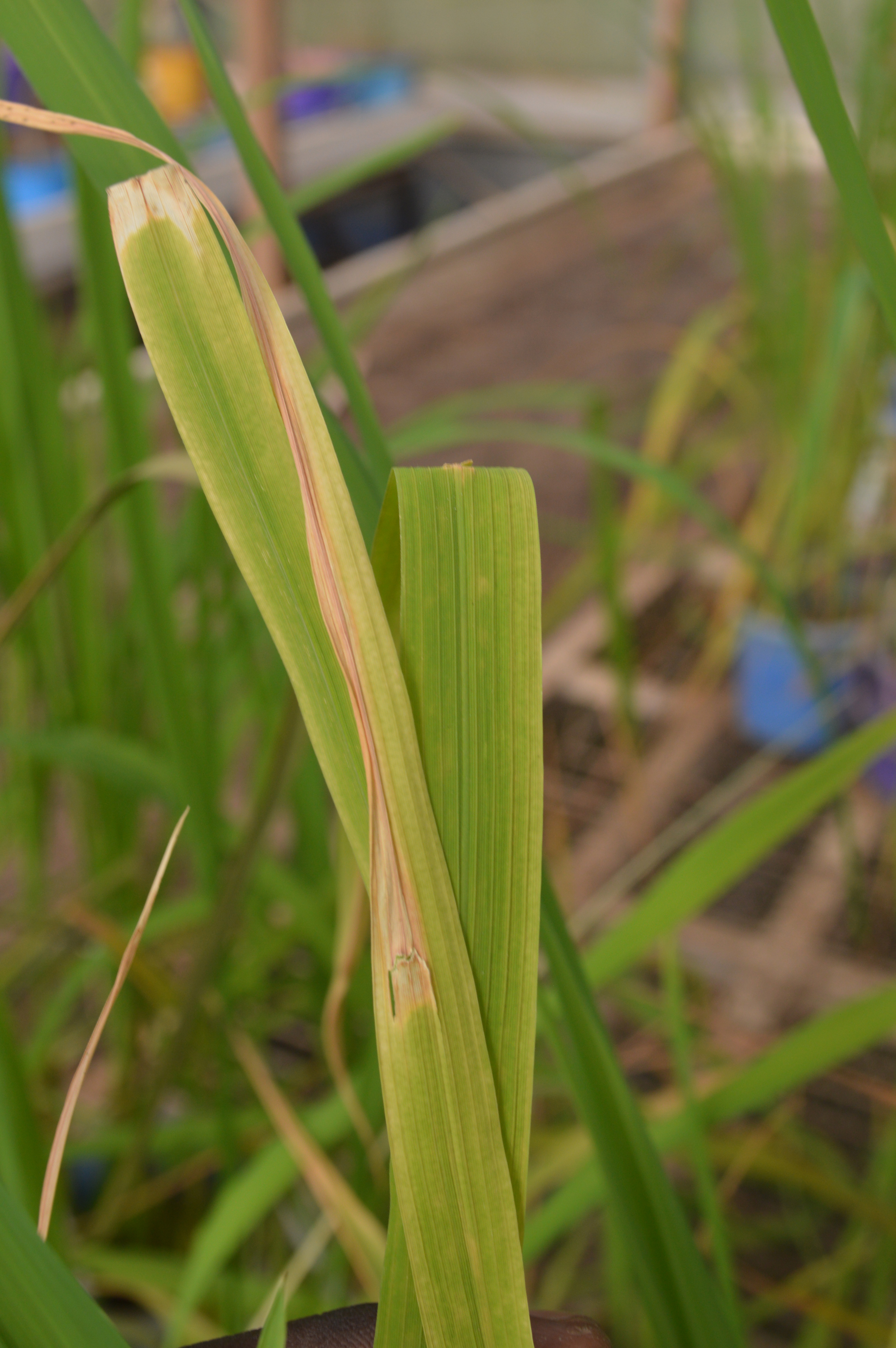
Figure 1. Typical Pantoea-induced symptoms developed on leaves inoculated with either P. stewartii or P. agglomerans using the leaf infiltration method (front leaf) compared to the absence of symptoms on rice leaves inoculated using the leaf clipping method (back leaf)
Materials and Reagents
- Latex gloves
- 2 ml micro-centrifuge tubes (Dominique DUTSCHER, catalog number: 0 33297 )
- 1 liter plastic pots
- 50 ml Falcon tube (Sigma, catalog number: CLS430828 )
- 500 ml wash bottle
- Plates 96 wells (VWR, catalog number: 735-0083 )
- 10, 20, 200, and 1,000 μl tips (Eppendorf, catalog number: 2231300008 )
- Paper towel
- Petri dishes
- Inoculating loop
- Marker
- Parafilm
- Fertilizer (urea and NPK 15-15-15 beaded and pelletized)
- Blunt-ended (needleless) syringes
- Sterilized field Soil
- Brand® UV cuvettes macro, chamber volume 2.5-4.5 ml (Sigma, catalog number: Z637157 )
- Icebox
- Plant materials: Rice seeds, including control accessions (susceptible, partially and highly resistant)
- Pantoea spp. Strains
- Hydrochloric acid (HCl)
- Alcohol
- Sterilized ultra-pure water
- Peptone (EuroMedex, catalog number: P3300 )
- Beef extract (Merck, CAS no. 68990-09-0)
- Sucrose (Merck, CAS no. 57-50-1)
- Glucose (Sigma, CAS no. 50-99-7)
- Yeast extract (Merck, CAS no. 8013-01-2)
- Tryptone (Merck, CAS no. 91079-40-2)
- Glutamic acid (Merck, CAS no. 56-86-0)
- Peptone Sucrose Agar (PSA plates) (see Recipes)
- 10 N HCl (see Recipes)
- 70% ethanol (see Recipes)
- Inoculum (see Recipes)
Equipment
- Tweezers
- Autoclave machine
- Nethouse, greenhouses/screenhouses/growth chambers
- Mortars and pestles
- MilliQ sterile ultrapure water system
- Laminar flow cabinet
- 10, 20, 200, and 1,000 μl pipettes
- -20 °C or deep freezer
- 28 °C growing incubator
- Spectrophotometer
- Vortexer
- pH meter
- Microcentrifuge
- Precision balance
Procedure
文章信息
版权信息
© 2020 The Authors; exclusive licensee Bio-protocol LLC.
如何引用
Kini, K., Agnimonhan, R., Wonni, I. and Silue, D. (2020). An Efficient Inoculation Technique to Assess the Pathogenicity of Pantoea Species Associated to Bacterial Blight of Rice. Bio-protocol 10(17): e3740. DOI: 10.21769/BioProtoc.3740.
分类
植物科学 > 植物免疫 > 病害症状
植物科学 > 植物免疫 > 宿主-细菌相互作用
您对这篇实验方法有问题吗?
在此处发布您的问题,我们将邀请本文作者来回答。同时,我们会将您的问题发布到Bio-protocol Exchange,以便寻求社区成员的帮助。
提问指南
+ 问题描述
写下详细的问题描述,包括所有有助于他人回答您问题的信息(例如实验过程、条件和相关图像等)。
Share
Bluesky
X
Copy link



